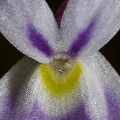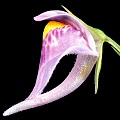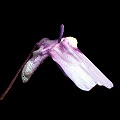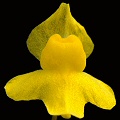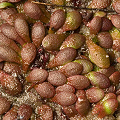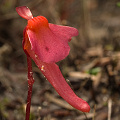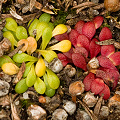Q: About terrestrial Utricularia
A: Most Utricularia are terrestrial species, which means they
live in moist, and usually
waterlogged soil. They may be perennials or annuals. Many of the annual
species are only annuals in the wild because their habitats dry up during some time of the year---in cultivation
they can survive as perennials, although convincing them to flower after their first year may be extremely
difficult. The bladders function underground where they are submerged in water.
The leaves of many terrestrial Utricularia species are so tiny that you may
not notice the plants in your collection until they flower. And while you may need a hand lens to appreciate the
tiny flowers, you will see that they really are lovely!
Two of the most commonly grown terrestrial Utricularia species are
U. subulata and U. bisquamata. These are weeds by any metric!
I have
several articles on the cultivation of terrestrial Utricularia on-line. These are
old, very old, but the horticultural information is still sound, and provide good general prescriptions:
Utricularia sandersonii
Utricularia calycifida
Utricularia delicatula & Utricularia lateriflora
Utricularia uniflora
Utricularia prehensilis
For your ease, I include an extended quote from the article on U. uniflora:
"I use a method that works for almost all the tropical Utricularia except
those that do better in live Sphagnum, and of course aquatics
and semi-aquatics. When carnivorous plant growers refer to "standard
Utricularia culture," the following procedure (or close
to it) is usually what is meant. Use either pure dead milled Sphagnum
or a 2:1 peat-sand mix in a 5 cm (2") pot. I use water purified
by distillation or reverse osmosis and keep the water table at least
a few cm beneath the soil surface. For established plants Slack suggests
raising the water table above the soil surface but I don't....Keep
them warm year round, around 20-30°C (68-86°F). If the
plants are kept warmer they will survive but the flowers do not last
as long. Since they are found in shady places in the wild I give them
medium light. While this means some shade in the greenhouse, the light
available in most 4-6 fluorescent bulb terrarium set-ups is fine.
Even in the best conditions, U. uniflora does not grow quickly.
It takes several months to fill the surface of a 5 cm pot with its
little leaves. Its stolons do not explore too deeply into the pot,
and I have never seen the plant grow out of the bottom as often happens
with other species. Still, it is easy to propagate---carefully detach
from the mother pot a hunk of leaves, stolons, and bladders, and plant
it in a new pot. In time you will be rewarded with a display of lovely
and long-lived flowers."
Follow those rules, and you will do just fine. Of course, there are
exceptions to everything, and in this case it is U. menziesii, a tuberous
species from Western Australia that enters a difficult dormancy each summer.
If you are growing this, my hat is off to you. I have not managed to encourage
this plant to live past one season, so I have no advice for you.
Page citations: Lloyd, F.E. 1942; Rice, B.A. 1994a, 2006a;
Schlauer, J. 2002; Taylor, P. 1989; personal observations.
